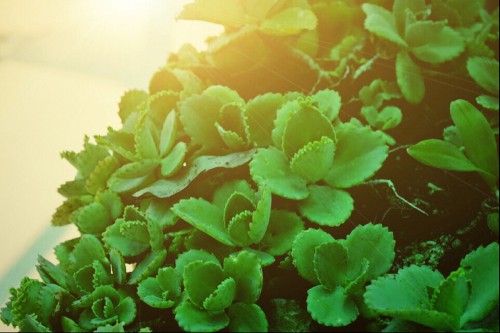Kalanchoe is a popular succulent plant that is known for its beautiful blooms and low maintenance requirements. However, black spots on kalanchoe leaves can be a cause for concern for many gardeners. These spots can appear for a variety of reasons, and it is important to identify the cause in order to properly treat and prevent them.
Identifying black spots on kalanchoe leaves is the first step in determining the cause of the problem. Black spots can vary in size and appearance, but they are usually circular or irregularly shaped and may be accompanied by yellowing or wilting of the leaves.
In some cases, the spots may also be raised or have a fuzzy texture. Once the spots have been identified, it is important to investigate the potential causes in order to prevent further damage to the plant.
Common causes of black spots on kalanchoe leaves include bacterial and fungal infections, pests, and environmental factors such as overwatering or exposure to extreme temperatures.
Different kalanchoe diseases can also cause black spots, such as bacterial leaf spot or powdery mildew. Understanding the cause of the black spots is crucial in determining the best course of treatment and prevention.
Identifying Black Spots on Kalanchoe Leaves

Kalanchoe is a popular succulent plant that is known for its attractive foliage and vibrant blooms. However, like all plants, kalanchoe can be susceptible to various diseases and pests. One of the most common issues that kalanchoe owners face is the appearance of black spots on the leaves.
Appearance
Black spots on kalanchoe leaves can vary in size and shape. They may appear as small, circular spots or larger, irregularly-shaped blotches. The spots may be raised or sunken and can range in color from black to dark brown. In some cases, the spots may be surrounded by a yellow or brown halo.
Symptoms
Black spots on kalanchoe leaves can be a sign of several different issues, including fungal or bacterial infections, insect infestations, or environmental stress. In addition to the spots themselves, other symptoms may include:
- Leaf wilting or drooping
- Leaf yellowing or browning
- Stunted growth
- Leaf curling or distortion
If left untreated, black spots on kalanchoe leaves can spread and cause significant damage to the plant. Therefore, it is important to identify the underlying cause of the spots and take appropriate action.
Causes
There are several potential causes of black spots on kalanchoe leaves. Some of the most common include:
- Fungal or bacterial infections: Fungal and bacterial infections can cause black spots to appear on kalanchoe leaves. These infections are often the result of overwatering or poor air circulation.
- Insect infestations: Certain insects, such as spider mites and thrips, can cause black spots to form on kalanchoe leaves. These pests feed on the plant’s sap and can lead to significant damage if left unchecked.
- Environmental stress: Environmental factors, such as extreme temperatures or low humidity, can cause black spots to appear on kalanchoe leaves.
In order to effectively treat black spots on kalanchoe leaves, it is important to identify the underlying cause of the issue. This may involve inspecting the plant for signs of pests or disease, adjusting watering or humidity levels, or moving the plant to a more suitable location.
You will also like these other related posts:
Black Spots on Kalanchoe Leaves – 7 Common Problems
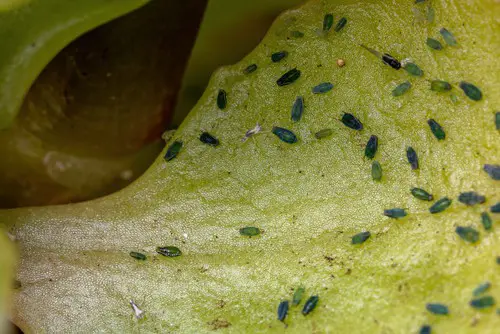
Kalanchoe is a beautiful and easy-to-care-for plant, but sometimes it can develop black spots on its leaves, which can be unsightly and indicate a problem. Here are some common causes of black spots on kalanchoe leaves:
1. Overwatering
Overwatering is one of the most common causes of black spots on kalanchoe leaves. When the soil is too moist, it can lead to root rot, which can cause black spots on the leaves. To prevent overwatering, make sure the soil is well-draining and only water the plant when the top inch of soil is dry to the touch.
2. Infestation
Infestations of pests like scale and aphids can cause black spots on kalanchoe leaves. These pests feed on the plant’s sap, which can lead to discoloration and black spots. To prevent infestations, regularly inspect your plant for signs of pests and treat them promptly if you find any.
3. Mildew
Mildew is a fungal disease that can cause black spots on kalanchoe leaves. It thrives in warm, humid conditions and can spread quickly if left untreated. To prevent mildew, make sure the plant is in a well-ventilated area and avoid getting the leaves wet when watering.
4. Bacterial Disease
Bacterial diseases can also cause black spots on kalanchoe leaves. These diseases are usually caused by overwatering or poor soil drainage. To prevent bacterial diseases, make sure the soil is well-draining and avoid over watering the plant.
5. Fungi and Mold
Fungi and mold can also cause black spots on kalanchoe leaves. These organisms thrive in warm, humid conditions and can spread quickly if left untreated. To prevent fungi and mold, make sure the plant is in a well-ventilated area and avoid getting the leaves wet when watering.
6. Phytophthora
Phytophthora is a soil-borne pathogen that can cause black spots on kalanchoe leaves. It can be difficult to treat once it has infected the plant, so prevention is key. To prevent phytophthora, make sure the soil is well-draining and avoid over watering the plant.
Viruses
Viruses can also cause black spots on kalanchoe leaves. These diseases are usually spread by insects or contaminated tools, so it’s important to practice good hygiene when caring for your plant. To prevent viruses, regularly inspect your plant for signs of disease and treat them promptly if you find any.
Kalanchoe Diseases Related to Black Spots
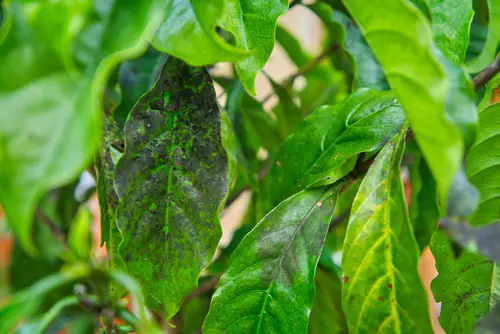
Black spots on kalanchoe leaves can be an indication of several diseases. The most common diseases associated with black spots on kalanchoe leaves are powdery mildew, root rot, stem rot, and phytophthora rot.
Powdery mildew is a fungal disease that causes a white or gray powdery coating on the leaves. As the disease progresses, black spots may appear on the leaves. Powdery mildew can be controlled by improving air circulation around the plant, avoiding overhead watering, and treating the plant with a fungicide.
Root rot is a disease caused by overwatering or poor drainage. It can cause black spots on the leaves, as well as wilting and yellowing of the leaves. To prevent root rot, ensure that the plant is not sitting in water and that the soil has good drainage.
Stem rot is a fungal disease that causes the stem of the plant to turn black and mushy. This disease can spread to the leaves, causing black spots. Stem rot can be prevented by avoiding overwatering and providing good air circulation around the plant.
Phytophthora rot is a disease caused by a water mold that thrives in wet soil. It can cause black spots on the leaves, as well as wilting and yellowing of the leaves. To prevent phytophthora rot, ensure that the plant is not sitting in water and that the soil has good drainage.
Pests That Cause Black Spots
Kalanchoe plants are susceptible to a variety of pests that can cause black spots on their leaves. These black spots can be caused by several factors, including fungal infections, bacterial infections, and pests. In this section, we’ll focus on the pests that commonly cause black spots on kalanchoe leaves.
1. Aphids
Aphids are small, sap-sucking insects that can cause black spots on kalanchoe leaves. They are typically found on the undersides of leaves and can be identified by their pear-shaped bodies. Aphids can be green, yellow, brown, or black, and they reproduce quickly, so it’s important to act fast if you notice an infestation.
2. Scale Insects
Scale insects are another common pest that can cause black spots on kalanchoe leaves. These insects are typically gray or brown and have a protective covering that makes them difficult to remove. They can be found on the leaf folds, behind the leaf bases, or inside the blooms.
3. Mealybugs
Mealybugs are another sap-sucking insect that can cause black spots on kalanchoe leaves. They are small, white, and fluffy and can be found on the undersides of leaves or in the crevices between leaves and stems. Mealybugs can be difficult to get rid of, so it’s important to act quickly if you notice an infestation.
4. Spider Mites
Spider mites are tiny, eight-legged pests that can cause black spots on kalanchoe leaves. They are typically found on the undersides of leaves and can be identified by their web-like structures. Spider mites are difficult to see with the naked eye, so it’s important to look for their webbing if you suspect an infestation.
Environmental Factors
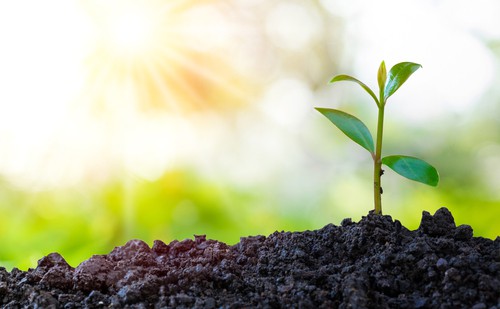
Kalanchoe plants are sensitive to environmental factors, and black spots on the leaves can be a sign of various issues. These spots can be caused by both biotic and abiotic factors.
1. Light
Kalanchoe plants require bright, indirect light to thrive. If the plant is exposed to too much direct sunlight, it can cause the leaves to turn yellow and develop black spots. On the other hand, if the plant is kept in low light conditions, it can cause the leaves to become leggy and weak, which can make them more susceptible to disease.
2. Water
Overwatering or underwatering can both cause black spots on kalanchoe leaves. If the plant is overwatered, it can lead to root rot, which can cause black spots on the leaves. Conversely, if the plant is underwatered, it can cause the leaves to become dry and brittle, which can also lead to black spots.
3. Soil
Kalanchoe plants require well-draining soil to prevent waterlogging, which can lead to root rot and black spots on the leaves. If the soil is too compact or heavy, it can prevent proper drainage and cause the plant to become waterlogged.
4. Temperature and Humidity
Kalanchoe plants prefer moderate temperatures and humidity levels. If the temperature is too low or too high, it can cause stress on the plant, which can lead to black spots on the leaves. Similarly, if the humidity level is too low, it can cause the leaves to dry out and become more susceptible to disease.
5. Dry Air
Dry air can also cause black spots on kalanchoe leaves. If the air in the room is too dry, it can cause the leaves to become dry and brittle, which can make them more susceptible to disease. To prevent this, it is recommended to mist the leaves regularly or use a humidifier to increase the humidity levels in the room.
6. Excess Water and Lack of Water
Both excess water and lack of water can cause black spots on kalanchoe leaves. If the plant is overwatered, it can cause the roots to become waterlogged, which can lead to root rot and black spots on the leaves. Conversely, if the plant is underwatered, it can cause the leaves to become dry and brittle, which can also lead to black spots.
Impact of Black Spots on Kalanchoe
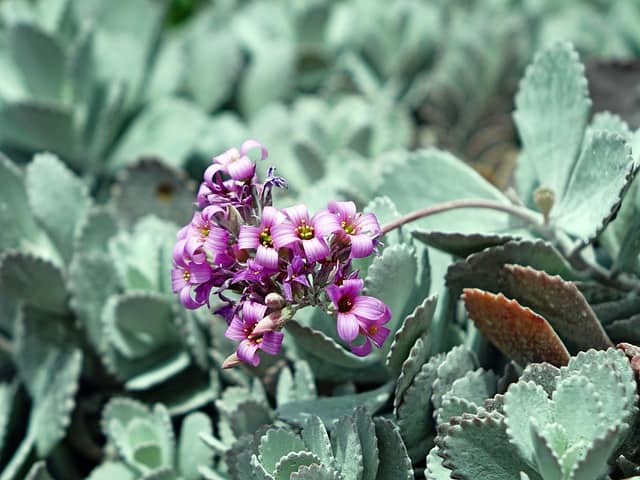
Black spots on kalanchoe leaves can have a significant impact on the health and appearance of the plant. These spots are often a sign of a fungal or bacterial infection, which can quickly spread and cause irreversible damage if left untreated.
One of the most noticeable impacts of black spots on kalanchoe is yellowing and wilting of the affected leaves. The spots can cause the leaves to lose their vibrant green color and become discolored, which can make the plant look unattractive and unhealthy.
In some cases, the affected leaves may become mushy and start to rot, which can lead to stunted growth and reduced flowering. This can be especially problematic for kalanchoe plants, which are known for their beautiful and vibrant blooms.
Another common impact of black spots on kalanchoe is leaf drop. As the infection spreads, the affected leaves may start to fall off the plant, which can further weaken the plant and make it more susceptible to other diseases and pests.
To prevent the spread of black spots on kalanchoe, it is important to remove any affected leaves as soon as possible and treat the plant with a fungicide or bactericide. It is also important to avoid overwatering the plant, as excess moisture can create the perfect environment for fungal and bacterial growth.
Preventing Black Spots on Kalanchoe
Black spots on kalanchoe leaves can be caused by a number of factors, including fungal diseases, bacterial infections, and insect infestations. Fortunately, there are several steps that can be taken to prevent these unsightly spots from appearing in the first place.
Proper Plant Care
One of the most important things that can be done to prevent black spots on kalanchoe leaves is to provide proper care for the plant. This includes ensuring that the plant is grown in a pot that provides adequate drainage and is filled with well-drained soil.
The potting mix should be kept moist but not waterlogged, and the plant should be watered only when the top inch of soil feels dry to the touch.
Fertilizer
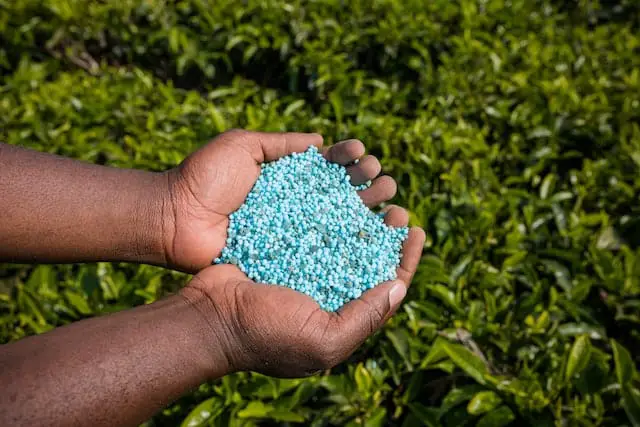
Over Fertilizing can also lead to black spots on kalanchoe leaves. It is important to use a balanced fertilizer and to follow the instructions carefully. Fertilizer should be applied only during the plant’s active growing season, which is typically in the spring and summer.
Container
The container in which the kalanchoe is grown should be cleaned regularly to prevent the buildup of harmful bacteria and fungi. This can be done by washing the pot with a solution of one part bleach to nine parts water, or by using a commercial disinfectant.
Insect Infestations
Insect infestations can also lead to black spots on kalanchoe leaves. To prevent this, it is important to inspect the plant regularly for signs of pests such as aphids, mealybugs, and spider mites. If an infestation is detected, it can be treated with insecticidal soap or horticultural oil.
Treatment for Black Spots on Kalanchoe
Black spots on Kalanchoe leaves can be caused by a variety of factors, including fungal infections, bacterial infections, and insect infestations. Fortunately, there are several treatment options available to help get rid of these unsightly spots and keep your Kalanchoe healthy.
One effective treatment for black spots on Kalanchoe leaves is horticultural oil. This oil can be applied to the leaves to help smother any insects that may be causing the black spots. It is important to follow the instructions on the label carefully when using horticultural oil, as using too much can damage the plant.
Another option is to use an insecticide to kill any insects that may be causing the black spots. Insecticides can be applied directly to the leaves, or they can be used as a soil drench. It is important to choose an insecticide that is safe for use on Kalanchoe plants and to follow the instructions on the label carefully.
Fungicides can also be used to treat black spots on Kalanchoe leaves that are caused by fungal infections. These products work by killing the fungus that is causing the spots. It is important to choose a fungicide that is safe for use on Kalanchoe plants and to follow the instructions on the label carefully.
Neem oil is another effective treatment for black spots on Kalanchoe leaves. This oil is derived from the neem tree and has natural insecticidal and fungicidal properties. Neem oil can be applied directly to the leaves to help get rid of any insects or fungi that may be causing the black spots.
Insecticidal soap is a gentle and effective treatment for black spots on Kalanchoe leaves that are caused by insects. This soap can be sprayed directly onto the leaves to help get rid of any insects that may be causing the spots. It is important to follow the instructions on the label carefully when using insecticidal soap, as using too much can damage the plant.
Finally, dabbing the black spots with a cotton swab saturated in alcohol can help get rid of any insects that may be causing the spots. This method is particularly effective for treating spider mites, which can cause black spots on Kalanchoe leaves.
Repotting Kalanchoe with Black Spots
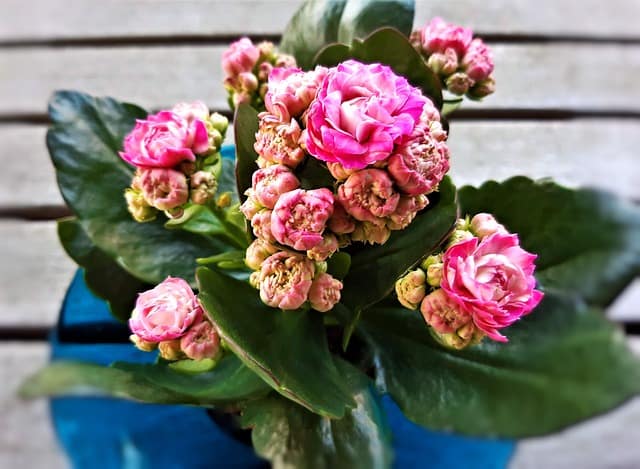
If your kalanchoe plant has black spots on its leaves, it may be a sign of a fungal or bacterial infection. In some cases, the cause may be due to overwatering or inadequate drainage. Repotting the kalanchoe plant can help alleviate the problem.
Before repotting, check the roots of the kalanchoe plant. If the roots are tightly packed and circling the bottom of the pot, the plant is rootbound. Repotting is necessary in this case to prevent further root damage.
To repot the kalanchoe plant, choose a pot that is one size larger than the current pot. Use a well-draining potting soil, such as cactus or succulent mix. Remove the kalanchoe plant from its current pot and gently loosen the roots. Trim any damaged or dead roots with clean shears.
Place the kalanchoe plant in the new pot and fill in any gaps with fresh potting soil. Press down gently to ensure the plant is secure. Water the plant thoroughly and place it in a bright, indirect light.
Repotting the kalanchoe plant can help improve its overall health and prevent the spread of black spots on the leaves. It is important to avoid overwatering and ensure proper drainage to prevent future fungal or bacterial infections.
Understanding Kalanchoe Varieties
Kalanchoe is a genus of succulent plants that belongs to the Crassulaceae family. These plants are native to Madagascar and tropical Africa and are widely cultivated as ornamental plants due to their attractive foliage and colorful flowers. There are more than 100 species of kalanchoe, and each one has its unique characteristics.
One of the most popular species of kalanchoe is the Kalanchoe blossfeldiana, which is also known as the Flaming Katy. This species is native to Madagascar and has bright red, pink, white, or orange flowers that bloom in clusters. It is a popular indoor plant that requires minimal care and is ideal for beginners.
Kalanchoe plants are available in various colors, including red and white. The red kalanchoe is known for its bright red flowers and is often used as a decorative plant during Christmas and Valentine’s Day. The white kalanchoe, on the other hand, has white flowers and is often used as a wedding flower.
Apart from the Kalanchoe blossfeldiana, there are several other species of kalanchoes, including the Kalanchoe tomentosa, Kalanchoe pinnata, and Kalanchoe daigremontiana. Each species has its unique characteristics, such as leaf shape, color, and texture.
It is essential to choose the right kalanchoe variety that suits your needs and preferences. Before purchasing a kalanchoe plant, it is recommended to research the different species and their care requirements. This will help you choose a plant that is easy to care for and will thrive in your environment.
Conclusion
Black spots on kalanchoe leaves can be caused by a variety of factors, including overwatering, bug infestations, and bacterial or fungal infections. It is important to identify the root cause of the problem in order to effectively treat and prevent it from recurring.
Kalanchoe plants are a type of succulent that are known for their fleshy leaves and drought-tolerant nature. They make great houseplants and are relatively low-maintenance, making them a popular choice for indoor gardening.
To ensure the health of your kalanchoe plant, it is important to provide it with the proper growing conditions. This includes well-draining soil, such as a mix of peat moss and perlite, and avoiding overwatering.
If you notice black spots on your kalanchoe leaves, it is important to act quickly to prevent the spread of the issue. This may include removing affected leaves, treating the plant with an appropriate fungicide or pesticide, and adjusting the plant’s growing conditions as needed.
Frequently Asked Questions
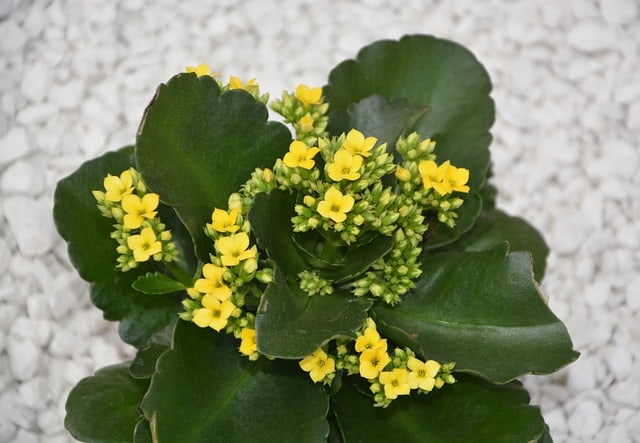
How to treat black spots on kalanchoe leaves?
If your kalanchoe leaves have black spots, it is important to take action as soon as possible. The first step is to remove the infected leaves carefully. You can use a pair of scissors or pruning shears to cut off the affected leaves.
Make sure to sterilize the tools before and after use. You can use a solution of one part bleach to nine parts water to disinfect the tools.
After removing the infected leaves, you can apply a fungicide to the remaining leaves. Copper-based fungicides are effective against fungal diseases that cause black spots on kalanchoe leaves. Follow the manufacturer’s instructions carefully when applying the fungicide.
What causes black spots on kalanchoe leaves?
Black spots on kalanchoe leaves can be caused by several factors, including fungal and bacterial diseases, overwatering, and poor air circulation. Fungal diseases such as black spot and leaf spot can cause black spots on kalanchoe leaves. Bacterial diseases such as bacterial leaf spot can also cause black spots.
Overwatering can lead to root rot, which can cause black spots on the leaves. Poor air circulation can also contribute to the development of fungal and bacterial diseases.
How to prevent black spots on kalanchoe leaves?
To prevent black spots on kalanchoe leaves, it is important to provide the plant with the right growing conditions. Make sure the plant is not overwatered and has good drainage. Provide adequate air circulation around the plant by placing it in a well-ventilated area.
Avoid getting water on the leaves when watering the plant. Water the plant at the base to prevent fungal and bacterial diseases from spreading.
What are some common diseases of kalanchoe plants?
Kalanchoe plants are susceptible to several diseases, including fungal and bacterial diseases. Fungal diseases such as black spot, leaf spot, and powdery mildew can affect kalanchoe plants. Bacterial diseases such as bacterial leaf spot and soft rot can also affect the plant.
How to identify and treat kalanchoe pests and diseases?
To identify and treat kalanchoe pests and diseases, it is important to inspect the plant regularly. Look for signs of damage, such as yellowing leaves, black spots, or wilting. Use a magnifying glass to inspect the plant for pests such as spider mites or mealybugs.
If you identify a pest or disease, take action immediately. Remove infected leaves and apply a fungicide or insecticide as necessary. Follow the manufacturer’s instructions carefully when applying the treatment.
What are the best practices for watering kalanchoe plants to avoid leaf spots?
To avoid leaf spots on kalanchoe plants, it is important to water the plant correctly. Water the plant deeply and then allow the soil to dry out before watering again. Avoid getting water on the leaves when watering the plant. Water the plant at the base to prevent fungal and bacterial diseases from spreading.

Hey, I’m Lisa and I’ve been an avid gardener for over 30 years. I love writing, talking and living in the garden! Feel free to connect with me on my socials below

